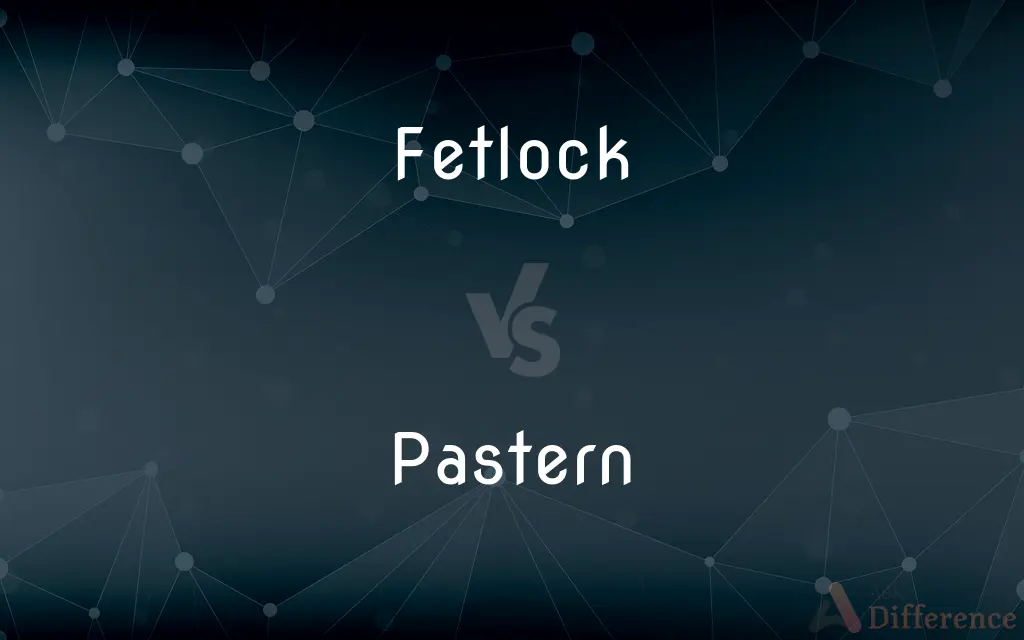Fetlock vs. Pastern — What's the Difference?
By Tayyaba Rehman & Urooj Arif — Updated on April 5, 2024
The fetlock is the joint connecting the cannon bone to the pastern in horses, providing shock absorption, whereas the pastern comprises two bones linking the fetlock to the hoof, affecting stride and comfort.

Difference Between Fetlock and Pastern
Table of Contents
ADVERTISEMENT
Key Differences
The fetlock, located between the horse's cannon bone and the pastern, functions as a critical joint in the equine leg, allowing for flexion and extension necessary for movement. This joint is akin to a human's ankle, providing essential shock absorption during locomotion. On the other hand, the pastern, made up of two bones—the long and short pastern bones—extends from the fetlock joint to the hoof. It plays a significant role in determining the horse's stride length and overall comfort while moving.
In terms of anatomy, the fetlock is visible as a protruding joint that experiences a high degree of stress, especially in racing and jumping horses, making it susceptible to injuries such as sprains and fractures. Conversely, the pastern's health is vital for absorbing ground impact and ensuring smooth gaits. A long, sloping pastern generally indicates a smoother ride, whereas a short, upright pastern may lead to a rougher gait and increased shock to the leg structures.
From a care perspective, the fetlock requires monitoring for swelling or signs of injury, with protective gear often used during high-impact activities to prevent damage. The pastern, while less prone to dramatic injuries than the fetlock, still benefits from regular checks for abrasions or conditions like pastern dermatitis, which can affect the horse's comfort and performance.
The fetlock and pastern also differ in their response to treatment and injury recovery. Injuries to the fetlock may require extensive rest and rehabilitation due to the joint's complexity and load-bearing function. In contrast, pastern injuries, depending on their nature, might be managed with localized treatments and shorter recovery periods, though severe cases can still pose significant challenges.
In breeding and horse selection, both the fetlock and pastern are evaluated for conformation, as their structure greatly influences a horse's ability to perform in various disciplines. Ideal fetlock and pastern angles contribute to efficient movement and reduced injury risk, underscoring the interconnectedness of these anatomical features in equine health and athleticism.
ADVERTISEMENT
Comparison Chart
Location
Between cannon bone and pastern
Between fetlock and hoof
Composition
Joint
Two bones (long and short)
Function
Shock absorption, movement
Stride length, comfort
Injury Susceptibility
High, due to stress and impact
Lower, but crucial for comfort
Impact on Gait
Provides flexion and extension
Affects smoothness and shock absorption
Compare with Definitions
Fetlock
Critical for shock absorption during movement.
Protective boots can help safeguard the fetlock during jumping.
Pastern
The part of a horse's leg between the fetlock and the hoof, made up of two bones.
The horse's smooth gait was partly due to its long pasterns.
Fetlock
A horse's joint located between the cannon bone and the pastern, similar to a human ankle.
The horse's fetlock was swollen after the race.
Pastern
Important for overall leg health and performance.
Regular pastern care includes checking for abrasions.
Fetlock
Visible as a protrusion on the horse's leg.
She checked the fetlock for any signs of injury.
Pastern
Influences stride length and comfort.
A short pastern can lead to a rougher ride.
Fetlock
Requires careful monitoring and protection.
Wrapping the fetlock can prevent strains during intense activities.
Pastern
Less prone to severe injuries than the fetlock.
The pastern dermatitis was treated with a topical cream.
Fetlock
Prone to injuries due to high stress.
The veterinarian recommended rest for the injured fetlock.
Pastern
A long, sloping pastern absorbs more shock.
Horses with sloping pasterns often have softer steps.
Fetlock
Fetlock is the common name in horses, large animals, and sometimes dogs for the metacarpophalangeal and metatarsophalangeal joints (MCPJ and MTPJ). Although it somewhat resembles the human ankle in appearance, the joint is technically more similar to the ball of the foot.
Pastern
The pastern is a part of the leg of a horse between the fetlock and the top of the hoof. It incorporates the long pastern bone (proximal phalanx) and the short pastern bone (middle phalanx), which are held together by two sets of paired ligaments to form the pastern joint (proximal interphalangeal joint).
Fetlock
A projection on the lower part of the leg of a horse or related animal, above and behind the hoof.
Pastern
The part of a horse's foot between the fetlock and hoof.
Fetlock
A tuft of hair on such a projection.
Pastern
An analogous part of the leg of a dog or other quadruped.
Fetlock
The joint marked by such a projection.
Pastern
The part of a horse's leg between the fetlock joint and the hoof.
Fetlock
A joint of the horse's leg below the knee or hock and above the hoof.
Pastern
(obsolete) A shackle for horses while pasturing.
Fetlock
The tuft of hair that grows at this joint.
Pastern
(obsolete) A patten.
Fetlock
The cushionlike projection, bearing a tuft of long hair, on the back side of the leg above the hoof of the horse and similar animals. Also, the joint of the limb at this point (between the great pastern bone and the metacarpus), or the tuft of hair.
Their wounded steedsFret fetlock deep in gore.
Pastern
The part of the foot of the horse, and allied animals, between the fetlock and the coffin joint. See Illust. of Horse.
Fetlock
The joint between the cannon bone and the pastern
Pastern
A shackle for horses while pasturing.
Fetlock
Projection behind and above a horse's hoof
Pastern
A patten.
Pastern
The part between the fetlock and the hoof
Common Curiosities
What are the signs of a fetlock injury?
Signs of a fetlock injury include swelling, lameness, or visible discomfort in the horse's movement.
Why is pastern health important?
Pastern health is essential for absorbing ground impact, ensuring smooth gaits, and preventing discomfort or lameness in horses.
What is the fetlock in a horse?
The fetlock is a joint located between the cannon bone and the pastern in horses, crucial for movement and shock absorption.
Can fetlock injuries be prevented?
While not all injuries can be prevented, using protective gear and monitoring for signs of stress can reduce the risk of fetlock injuries.
How does the structure of the pastern contribute to shock absorption?
The pastern's bones and angle help dissipate ground forces, reducing the shock transmitted to the leg and the rest of the body.
How are pastern injuries treated?
Treatment varies depending on the injury but may include rest, localized treatments, and, in some cases, surgical intervention.
Can a horse recover from a severe pastern injury?
Recovery depends on the severity of the injury, but many horses can return to comfort and functionality with appropriate treatment.
What protective gear can be used for the fetlock?
Boots and wraps designed for horses can protect the fetlock from impacts and strains during high-activity levels.
What role does the fetlock play in jumping?
The fetlock's ability to flex and extend is vital in jumping, providing the necessary shock absorption upon landing.
How does the pastern affect a horse's gait?
The pastern's length and angle influence the horse's stride and comfort, with a longer pastern generally providing a smoother ride.
Is the pastern's angle genetically determined?
Yes, the angle and length of the pastern are influenced by genetics but can also be affected by nutrition and care.
How can conformation affect fetlock health?
Poor conformation can increase stress on the fetlock, leading to a higher risk of injury.
How does the ground surface impact fetlock and pastern health?
Hard or uneven surfaces increase the stress on these areas, potentially leading to injuries or discomfort.
Why is it important to regularly check the fetlock and pastern?
Regular checks can identify early signs of injury or disease, allowing for prompt treatment and prevention of more serious conditions.
What are common pastern disorders?
Common issues include pastern dermatitis and arthritis, affecting the horse's comfort and mobility.
Share Your Discovery

Previous Comparison
Famous vs. Superstar
Next Comparison
Amusement vs. FunAuthor Spotlight
Written by
Tayyaba RehmanTayyaba Rehman is a distinguished writer, currently serving as a primary contributor to askdifference.com. As a researcher in semantics and etymology, Tayyaba's passion for the complexity of languages and their distinctions has found a perfect home on the platform. Tayyaba delves into the intricacies of language, distinguishing between commonly confused words and phrases, thereby providing clarity for readers worldwide.
Co-written by
Urooj ArifUrooj is a skilled content writer at Ask Difference, known for her exceptional ability to simplify complex topics into engaging and informative content. With a passion for research and a flair for clear, concise writing, she consistently delivers articles that resonate with our diverse audience.















































